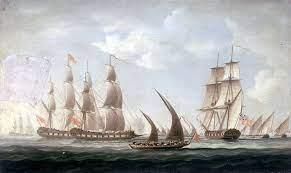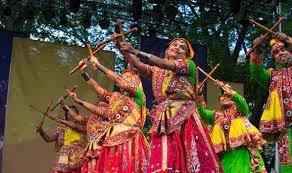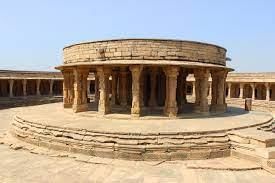History, Art & Culture - 5 | Current Affairs & Hindu Analysis: Daily, Weekly & Monthly - UPSC PDF Download
| Table of contents |

|
| Vajra Mushti Kalaga |

|
| Navy of Ancient India |

|
| Garba of Gujarat |

|
| Chausath Yogini Temple |

|
| ASI’s Stance on Religious Practices at Monuments |

|
| Dr. Rajendra Prasad |

|
Vajra Mushti Kalaga
The martial art form known as Vajra Mushti Kalaga, once prevalent, has now become extinct and is exclusively revived during the festival of Dasara.
About Vajra Mushti Kalaga
- Vajra Mushti Kalaga is a distinctive Indian martial art that integrates various hand-to-hand combat techniques, including grappling, wrestling, and striking techniques. The term "Vajra Mushti" translates to Thunderbolt Fist, highlighting its dynamic and forceful nature. What sets this martial art apart is the use of a knuckleduster, a small metal weapon worn on the knuckles of the fighter, typically crafted from animal horns.
- The primary goal of Vajra Mushti Kalaga is to neutralize the opponent and counter their weapon effectively. In contrast to conventional wrestling, this form entails two competitors, known as jettys, attempting to strike each other's head with the knuckleduster. The winner is determined by the first person to draw blood from their opponent's head.
- This unique wrestling style gained prominence during the reign of the Vijayanagar rulers, who held power from the 14th to the 17th centuries. The intensity of the matches is palpable, as the jettys strive to draw blood, and a referee intervenes at the first sign of bloodshed.
- Notably, Vajra Mushti Kalaga is not merely a sport; it is a visceral confrontation where the fighters engage in real combat. Historical accounts from medieval Portuguese travelers who witnessed this form of wrestling during Navaratri celebrations in the Vijayanagar empire provide detailed insights into its significance and intensity. Despite its rarity, the legacy of Vajra Mushti Kalaga endures as a testament to India's rich martial arts heritage.
Navy of Ancient India
On Navy Day, observed on December 4, 2004, the Prime Minister honored Chhatrapati Shivaji Maharaj by inaugurating his statue in Sindhugarh, Maharashtra.
Why is Navy Day celebrated on December 4th?
Navy Day is commemorated on December 4th annually by the Indian Navy to recognize its pivotal role and commemorate the accomplishments of 'Operation Trident' during the 1971 Indo-Pak War.
Noteworthy Announcements:
- Emphasizing Shivaji's naval acumen, the Prime Minister declared the introduction of naval epaulettes adorned with Shivaji's emblem.
- The newly designed Naval Ensign incorporates the octagonal design from Shivaji's seal.
- In tribute to the Maratha naval commander Kanhoji Angre, the Indian Navy named its training establishment (at Lonavala) as INS Shivaji and its logistics hub (at Mumbai) as INS Angre.
Garba of Gujarat
The traditional dance form of Gujarat, known as "Garba," has been included in the UNESCO Intangible Cultural Heritage list. This accolade marks it as the 15th cultural element from India to receive such recognition.
About
- As per the UNESCO statement, Garba is characterized as a ritualistic and devotional dance conducted throughout the nine-day Navaratri festival, dedicated to the worship of feminine energy or Shakti. This dance is observed in diverse settings such as homes, temple courtyards, public spaces, villages, urban squares, streets, and expansive open grounds, transforming it into a communal event with active participation.
- The inclusion in the UNESCO list is intended to safeguard the sustainability of this tradition and encourage the community to uphold and propagate the knowledge, skills, and oral traditions linked to Garba.
UNESCO Intangible Cultural Heritage List from India
- Koodiyattam: Sanskrit theatre of Kerala
- Vedic chanting: Recitation of sacred Hindu texts
- Ramlila: Traditional performance of the Ramayana
- Ramman: Religious festival and ritual theatre of Garhwal, Uttarakhand
- Chhau dance: Classical dance form of Odisha and West Bengal
- Kalbelia: Folk songs and dances of Rajasthan
- Mudiyett: Ritual theatre and dance drama of Kerala
- Ladakh Buddhist chantings: Recitation of sacred Buddhist texts in Ladakh
- Manipuri Sankirtana: Ritual singing, drumming, and dancing of Manipur
- Traditional brass and copper craft of utensil making: Thatheras of Jandiala Guru, Punjab
- Yoga: Ancient Indian physical, mental, and spiritual practices
- Kumbh Mela: Mass Hindu pilgrimage held at various locations in India
- Durga Puja in Kolkata: Religious festival of Hindu Goddess Durga in Kolkata, West Bengal
The list of UNESCO Intangible Cultural Heritage is a compilation curated by the United Nations Educational, Scientific and Cultural Organization (UNESCO). It aims to acknowledge and preserve cultural practices, traditions, knowledge, and skills deemed as intangible cultural heritage.
Chausath Yogini Temple
The construction of the Old Indian Parliament is thought to have drawn inspiration from the Chausath Yogini Temple in Madhya Pradesh.
The Historical Background of the Old Parliament House
- Constructed between 1921 and 1927, the Old Parliament Building was designed by British architects Edwin Lutyens and Herbert Baker. The foundation stone was laid in 1921 by HRH Prince Arthur, Duke of Connaught and Strathearn. The inauguration took place in January 1927, with Viceroy Lord Irwin establishing it as the seat of the Imperial Legislative Council. The third session of the Central Legislative Assembly convened in this building on 19 January 1927.
- After the British withdrawal from India, the Constituent Assembly of India took over the structure. Subsequently, following the enactment of India's Constitution on 26 January 1950, it became the official residence of the Indian Parliament. Over the span of 73 years, it served as the venue for the Lok Sabha and the Rajya Sabha, representing the lower and upper houses in India's bicameral parliament.
About the Chausath Yogini Temple
- Located in Mitaoli village, within the Morena district of Madhya Pradesh, the Chausath Yogini Temple holds historical significance. King Devpala of the Kachchhapaghata dynasty commissioned its construction, and it served as an educational center for astrology and mathematics, focusing on the Sun's transit.
- Acknowledged by the Archaeological Survey of India as an ancient and historical monument, the temple is alternatively known as the Ekattarso Mahadeva Temple due to the multitude of Shiva lingas present in its cells. The circular structure houses 64 chambers dedicated to the 64 yoginis, along with a central shrine dedicated to Shiva.
- Notably, the central shrine features slab coverings with perforations, facilitating the drainage of rainwater into a substantial underground storage. The temple's design has proven resilient to earthquake shocks, exhibiting no damage to its circular structural features over the past several centuries.
ASI’s Stance on Religious Practices at Monuments
A recent report addressing 'Concerns about Untraceable Monuments and Monument Protection in India,' presented by a parliamentary committee, proposes substantial modifications to the Archaeological Survey of India's (ASI) strategy concerning religious activities at safeguarded monuments.
- Previously, in May 2022, prayers conducted at the 8th-century Martand Sun Temple in Jammu and Kashmir raised apprehensions from the ASI, operating under the Ministry of Culture, citing a breach of regulations.
What is the Current ASI Policy Regarding Worship at Monuments?
- Presently, the Archaeological Survey of India (ASI) permits worship and rituals exclusively at monuments where these traditions were ongoing when the ASI assumed custody. The renowned Taj Mahal serves as a notable example of a living ASI monument, hosting namaz every Friday.
- Other distinguished living monuments encompass three mosques in Kannauj, the Roman Catholic Church in Meerut, the Nila Mosque in Delhi’s Hauz Khas Village, and various Buddhist monasteries in Ladakh. This restriction is implemented to safeguard the historical and cultural authenticity of these monuments.
- Religious rituals are prohibited at non-living monuments where there has been no continuous worship since ASI protection. The policy decision discourages the revival of worship in cases where it was not practiced at the time of protection or has been abandoned for an extended period.
- Out of the 3,693 centrally protected monuments and archaeological sites managed by the ASI, approximately a quarter (820) include places of worship, while the remaining are deemed non-living monuments where the initiation or conduct of new religious rituals is not permitted.
- These sites encompass diverse religious structures, including temples, mosques, dargahs, and churches. The Martand Sun Temple, commissioned by King Lalitaditya Muktapida of the Karkota dynasty, was once a flourishing place of worship but was destroyed in the 14th century.
- Although the ASI assumed control in the 20th century for conservation purposes, no Hindu rituals or puja were conducted. The recent pujas in 2022, organized by devotees, were deemed a violation of ASI norms for non-living monuments.
What are the Committee's Recommendations on Worship at ASI Monuments?
Recommendations:
- The committee suggests exploring the possibility of permitting prayers and worship at ASI-protected monuments with religious significance.
- This potential shift in policy raises questions about its implications for various religious sites.
- Recommends that the Ministry of Culture and ASI conduct surveys to identify monuments promptly and make the results public, stressing the importance of transparency and accountability in addressing critical issues related to monument protection.
Concerns Against the Committee's Recommendations:
- Allowing religious activities at protected monuments may pose a threat to the integrity, authenticity and historical value of the monuments, as they may be subjected to alterations, additions, modifications or damage by the devotees or the authorities.
- Allowing religious activities at protected monuments may also create conflicts and disputes among different religious groups, who may claim ownership or rights over the monuments, or object to the activities of other groups.
Dr. Rajendra Prasad
On December 3, 2022, at Rashtrapati Bhavan, the President of India offered floral tributes to Dr. Rajendra Prasad, the inaugural President of India, in commemoration of his birth anniversary.
Who was Dr. Rajendra Prasad?
Early Life:
- Born on December 3, 1884, in Zeradei, Siwan, Bihar, Dr. Rajendra Prasad was the son of Mahadev Sahai.
Education:
- Entering Calcutta Presidency College in 1902, Prasad pursued his master's in law at the University of Calcutta, where he excelled and earned a gold medal. In 1916, he began his legal career at the Patna High Court and later obtained a Doctorate in Law from Allahabad University in 1937.
Role in the Fight for Freedom:
Association with Gandhiji:
- Dr. Prasad's association with Mahatma Gandhi strengthened during the Champaran Satyagraha, where he played a pivotal role in addressing the grievances of local peasants.
- Gandhi's influence transformed Prasad's views, particularly on caste and untouchability.
Non-cooperation Movement:
- Dr. Prasad actively supported Gandhiji's call for non-cooperation and relinquished his law practice to establish a National College near Patna in 1921.
Salt Satyagraha:
- During the Salt Satyagraha in March 1930, under Dr. Prasad's guidance, a similar protest was launched in Nakhas Pond, Bihar.
- Despite facing imprisonment, he continued advocating for the cause.
Involvement with Indian National Congress:
Congress Leadership:
- Dr. Prasad joined the Indian National Congress in 1911 and presided over the Bombay session in October 1934.
- Following Subhash Chandra Bose's resignation in 1939, he was elected as Congress President.
Government Role:
- In 1946, Dr. Prasad became the Minister of Food & Agriculture in Pandit Jawaharlal Nehru's Interim Government, promoting the slogan "Grow More Food."
Contribution to the Constituent Assembly:
Constituent Assembly President:
- Elected President of the Constituent Assembly in July 1946, Dr. Prasad led various committees crucial to framing the Indian Constitution.
- Two and a half years after independence, on January 26, 1950, he became India's First President.
Awards & Recognition:
Bharat Ratna:
- Retiring in 1962, Dr. Prasad received the Bharat Ratna, India's highest civilian award.
Literary Contributions:
Published Works:
- Dr. Prasad documented his life and pre-independence decades in numerous books, including "Satyagraha at Champaran," "India Divided," "Atmakatha" (autobiography), "Mahatma Gandhi and Bihar," and "Bapu ke Kadmon Mein."
Death:
- After retiring to Sadaqat Ashram in Patna, Dr. Rajendra Prasad passed away on February 28, 1963, concluding a life dedicated to India's freedom struggle and its post-independence development.
|
38 videos|5288 docs|1117 tests
|
FAQs on History, Art & Culture - 5 - Current Affairs & Hindu Analysis: Daily, Weekly & Monthly - UPSC
| 1. What is Vajra Mushti Kalaga? |  |
| 2. What is the significance of the Navy of Ancient India? |  |
| 3. How is Garba celebrated in Gujarat? |  |
| 4. What is the significance of Chausath Yogini Temple? |  |
| 5. What is ASI's stance on religious practices at monuments? |  |




















